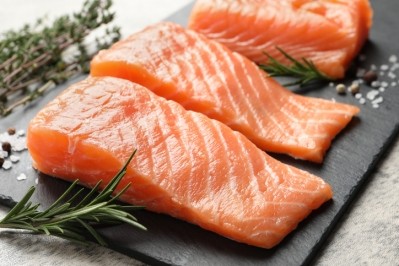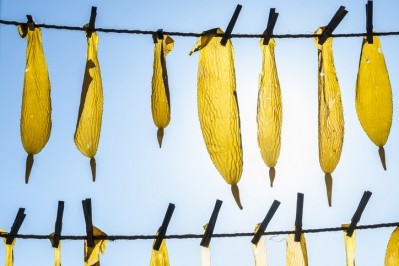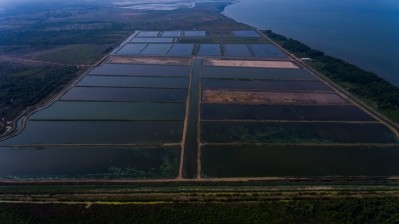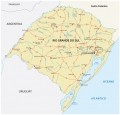Research team unlocks way to use cheaper feed in shrimp production
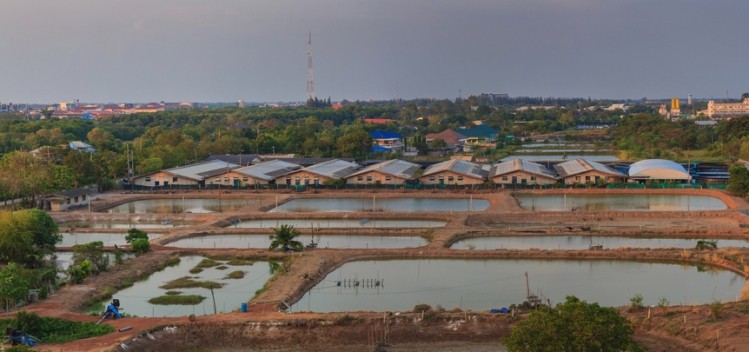
They examined the use of different types of commercial shrimp feeds and carbon/nitrogen (C/N) ratios on water quality and shrimp production in zero-exchange tanks.
“A six-week experiment in biofloc-based zero exchange tanks stocked with juvenile L. vannamei at a density of 300 m−3 was conducted to evaluate two commercial feeds in conjunction with four different C/N ratios,” the researchers said. “Treatments were evaluated on the basis of: (1) biofloc development and selected water quality indicators, (2) growth performance and feed utilization of shrimp, and (3) feed cost and variable cost.”
The research team found that feed type used and the C/N ratio influenced biofloc development, water, quality, shrimp performance, feeding levels and production costs, the researchers said.
Starting production in biofloc-rich water and adding limited amounts of organic carbon helped sustain development of the bioflocs in the zero-exchange system.
“Improved water quality, shrimp growth, and FCR were achieved when culture medium was supplemented with organic carbon to provide a C/N ratio of 12:1 for both feeds,” the researchers said. “Based on feed and variable costs analysis, it was more economical and appropriate to use the less expensive SI-35 feed at the density of 300 shrimp m−3 under the conditions of this study.”
The group published its work in the journal Aquaculture.
Why are carbon/nitrogen ratios important?
Pacific white shrimp is a commercially important shrimp species raised in several parts of the world. Development of intensive shrimp culture, however, has resulted in environmental damage and shrimp crop losses from disease – mainly linked to water exchange and effluent discharge, they said.
In response, there has been a move toward developing systems with limited or no water exchanged during the production process, which instead are biofloc-based, they said. The use of bioflocs may control water quality by removing toxic nitrogen elements while improving feed use and shrimp growth.
The C/N ratio for most commercial shrimp feeds designed to be used in an intensive aquaculture system is about 10:1, they said.
Adding carbohydrates or organic carbon in addition to what is available from the feed can increase the ratio to help develop bioflocs, and past research has found that once bioflocs mature water quality can be maintained with little or no carbon supplementation.
“Thus it is important to explore the impact of decreasing the amount of organic carbon supplementation without compromising shrimp performance to reduce input cost in zero-exchange biofloc technology (BFT) systems."
Additionally, in intensive shrimp production, feed costs are at least 50% of the total expense for raising a crop, said the researchers. Feed costs include feed price and the feed conversion ratio and both relate to feed formulation and quality.
Both formulation and quality also may alter water quality and shrimp performance, they said.
“When formulating commercial feeds for super- or hyper-intensive shrimp culture systems, more marine protein products and functional additives such as yeast extract, butanoic acid and astaxanthin are often included."
Some feeds have been designed to work with specific types of production systems, they said.
However, while improvements in production and aquaculture practices have been made, there have been few practical and economic evaluations to find optimal C/N ratios and feed type for shrimp production at high stocking densities and when biofloc-based, zero-exchange systems are used.
Methods and materials
In the trial, 32 tanks were stocked with biofloc-rich water and shrimp were added at 150 shrimp tank -1, the researchers said. Shrimp were given one of two commercial shrimp feeds – SI-35 and HI-35 – and at four C/N ratios – 9:1, 12:1, 15:1 and 18:1 for a period of six weeks.
The same amount of feed was given to every tank, and feed input was noted daily, they said.
“According to the manufacturer, the less expensive feed, SI-35 (US$0.99 kg−1) was formulated to have 35% crude protein (CP), 7% lipid and 4% fiber and was designed for semi-intensive shrimp culture systems,” they said. “The more expensive feed, HI-35 (US$1.75 kg−1) was formulated to have 35% CP, 7% lipid and 2% fiber, and was intended for hyper-intensive shrimp production systems.”
Molasses was used as a source of organic carbon to establish C/N ratios, they said. Ratios were determined based on carbon-nitrogen contents of the feed and molasses.
Water quality, salinity, dissolved oxygen (DO) and pH were measured twice a day, said the researchers. Additional water quality tests were done once a week.
Shrimp were harvested at the end of week six, numbers were recorded and total wet weight was measured, they said. Survival, growth rate, yield, feed conversion ratio were established and the cost to produce 1kg of shrimp was calculated.
Results
Bioflocs formed and developed in all tanks, the researchers said. Levels were altered by feed and C/N ratio.
“Feeding the shrimp two commercial feeds, one designed for semi-intensive culture systems and the other for hyper-intensive ones (SI-35 and HI-35), and supplementing the culture medium with different C/N ratios (9:1, 12:1, 15:1 and 18:1) had significant effects on biofloc development, water quality, growth performance, feed utilization, and input cost under the condition of the current study,” they said. Additional NaHCO3 was needed to maintain pH as C/N ratios increased with both feeds, they added.
All four C/N levels resulted in high survival with both feeds used, they said. “Final weight, growth rate, survival, yield and feed conversion ratio were significantly affected by feed and C/N ratio, and no interaction effect was detected,” they added.
The best shrimp final weights, growth rates and yields were found in shrimp raised with the C/N-12 tanks, they said. Those tanks also had shrimp with the lowest feed conversion ratios.
Costs of use for both diets increased as the C/N ratio raised, said the researchers. However, feed and variable costs were lower for all SI-35 tanks than for those getting the HI-35 diet.
“Analysis of feed and variable costs suggest improved economic benefits when using the less expensive feed of SI-35 under the conditions of this study,” they said. “Furthermore, input costs could be decreased using a C/N ratio of 12:1 due mainly to reduced molasses and NaHCO3 usage.”
“A long-term trial is needed to further evaluate the profitability and practicality of SI-35 feed and HI-35 feed for L. vannamei grow-out in biofloc-based, zero-exchange systems at an adjusted C/N ratio of 12:1,” they added.
Source: Aquaculture
Title: Effects of two commercial feeds for semi-intensive and hyper-intensive culture and four C/N ratios on water quality and performance of Litopenaeus vannamei juveniles at high density in biofloc-based, zero-exchange outdoor tanks
Authors: W J Xu, T Morris, T Samocha
DOI: doi.org/10.1016/j.aquaculture.2018.02.028
